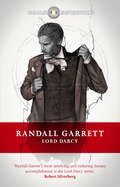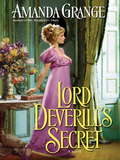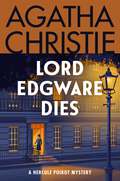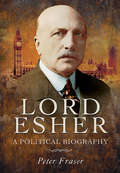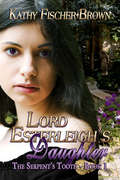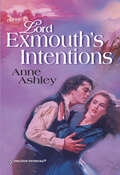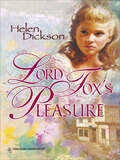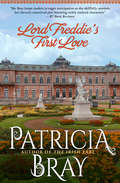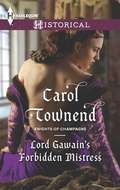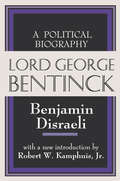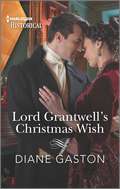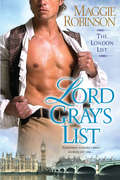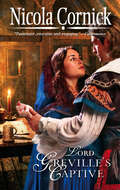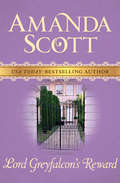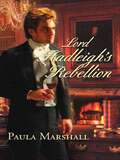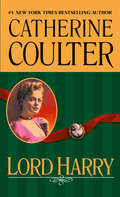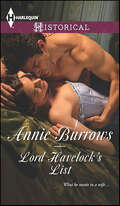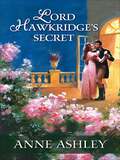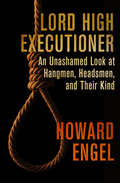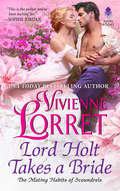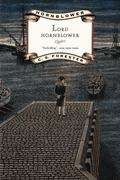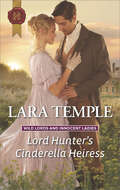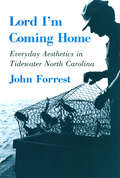- Table View
- List View
Lord Darcy (FANTASY MASTERWORKS)
by Randall GarrettWelcome to a world where the Plantagenet kings survived, the laws of magic were discovered and the physical sciences never pursued. In the resulting Anglo-French Empire, a detective like Lord Darcy needs more than a keen mind and an observant eye. Luckily, Darcy can call on the aid of Master Sean O'Lochlainn, forensic sorcerer.This omnibus contains all of the Lord Darcy stories as well as the only Lord Darcy novel, TOO MANY MAGICIANS, and has a new introduction by Michael Dirda.
Lord Dashwood Missed Out: A Spindle Cove Novella
by Tessa DareA snowstorm hath no fury like a spinster scornedMiss Elinora Browning grew up yearning for the handsome, intelligent lord-next-door...but he left England without a word of farewell. <P><P>One night, inspired by a bit too much sherry, Nora poured out her heartbreak on paper. Lord Dashwood Missed Out was a love letter to every young lady who'd been overlooked by gentlemen--and an instant bestseller. Now she's on her way to speak in Spindle Cove when snowy weather delays her coach. She's forced to wait out the storm with the worst possible companion: Lord Dashwood himself.And he finally seems to have noticed her.George Travers, Lord Dashwood, has traveled the globe as a cartographer. He returned to England with the goal of marrying and creating an heir--only to find his reputation shredded by an audacious, vexingly attractive bluestocking and her poison pen. Lord Dashwood Missed Out, his arse. Since Nora Browning seems to believe he overlooked the passion of a lifetime, Dash challenges her to prove it.She has one night.
Lord Deverill's Secret
by Amanda GrangeA delightful tale of romance and intrigue from the acclaimed author of Mr. Knightley's Diary. Arriving in Brighton, Cassandra Paxton had one important task-to uncover the meaning of a letter she'd found amidst her late brother's belongings. She knew of only one man who could help her: Lord Deverill, who just happened to be the most eligible bachelor in all of Brighton. But what she didn't realize-until it was too late-was that the handsome earl had a secret of his own. One that might prevent him from telling her the truth-and one that made a marriage between them impossible. Which was most unfortunate, considering the way his gentle touch made Cassandra's pulse quicken.
Lord Dufferin, Ireland and the British Empire, c. 1820–1900: Rule by the Best? (Routledge Studies in Modern British History)
by Annie TindleyThis book explores the life and career of Frederick Temple Hamilton-Temple-Blackwood, 1st Marquess of Dufferin and Ava (1826–1902). Dufferin was a landowner in Ulster, an urbane diplomat, literary sensation, courtier, politician, colonial governor, collector, son, husband and father. The book draws on episodes from Dufferin’s career to link the landowning and aristocratic culture he was born into with his experience of governing across the British Empire, in Canada, Egypt, Syria and India. This book argues that there was a defined conception of aristocratic governance and purpose that infused the political and imperial world, and was based on two elements: the inheritance and management of a landed estate, and a well-defined sense of ‘rule by the best’. It identifies a particular kind of atmosphere of empire and aristocracy, one that was riven with tensions and angst, as those who saw themselves as the hereditary leaders of Britain and Ireland were challenged by a rising democracy and, in Ireland, by a powerful new definition of what Irishness was. It offers a new perspective on both empire and aristocracy in the nineteenth century, and will appeal to a broad scholarly audience and the wider public.
Lord Edgware Dies: A Hercule Poirot Mystery (Hercule Poirot Mysteries #9)
by Agatha ChristieWhen Lord Edgware Dies a most unnatural death, detective Hercule Poirot must solve a most confounding conundrum: if the obvious killer, the slain peer’s spiteful wife, didn’t do it, who did? A classic from the queen of mystery, Agatha Christie.When Lord Edgware is found murdered the police are baffled. His estranged actress wife was seen visiting him just before his death and Hercule Poirot himself heard her brag of her plan to “get rid” of him.But how could she have stabbed Lord Edgware in his library at exactly the same time she was seen dining with friends? It’s a case that almost proves to be too much for the great Poirot.
Lord Esher: A Political Biography
by Peter FraserAlthough wielding huge influence in late Victorian and Edwardian political life, Reginald Baliol Brett (1852 1930), the second Lord Esher was, an enigma to his contemporaries and still remains a puzzle to historians.At the heart of British and Imperial political affairs for several decades, Esher sat in both Houses of Parliament, was a high ranking civil servant, friend and confidential advisor to three Sovereigns and four Prime Ministers (of differing political hues) and yet refused high office offered by both Liberals and Conservatives. Yet his behind-the-scenes influence through his range of friends in high places gave him unmatched, some thought undemocratic, power. Despite his lack of military service he was instrumental through his work on the Committee for Imperial Defence (CID) and its Secretarial for the wholesale reorganisation of the Armed Forces. It could be said that Esher, with his grasp of power without responsibility, was a unique phenomenon in British history.The Author, while compiling this fascinating study, drew on Cabinet and CID files, the Royal Archives and the papers of the Esher, Balfour, Asquith and Lloyd George estates. The result is a brilliant readable yet scholarly addition to British political bibliography.
Lord Esterleigh's Daughter (The Serpent's Tooth #1)
by Kathy Fischer-BrownAs a child, Anne Fairfield dreams of the father she never knew, the hero who died fighting the French and their Indian allies in a land across the sea. Her mother’s stories, and fantasies of her own devising, sustain and nurture her through a poor and lonely existence. Until one winter night, a strange man comes to call, and the life she has known comes crashing down like shattered glass. Forced to confront sordid truths, secrets and lies, the headstrong young woman begins to learn that, like generations of Darvey women ruled by their hearts, she is destined to follow in their footsteps. Set against the backdrop of 18th century England, Lord Esterleigh’s Daughter is the first book in “The Serpent’s Tooth” trilogy, which follows Anne from the rural countryside, to London society and into the center of the American Revolution.
Lord Exmouth's Intentions
by Anne AshleyA young woman disappears. A husband is suspected of murder. Stirring times for all the neighborhood.Demure vicar's daughter Robina Percival has relished her Season in Town-a definite change for the better after her somewhat straitened situation at home. But what is she to make of Daniel, Lord Exmouth? A widower with two daughters to raise, he appears to be in the market for a wife. Discovering that she has more spirit than she realized, Robina holds back from encouraging her potential suitor. How can she be sure he hasn't buried his heart with his beautiful wife?Regency DramaIntrigue, mischief...and marriageThe Steepwood Scandal
Lord Fox's Pleasure
by Helen DicksonMARRIAGE IN MINDWith the restoration of King Charles II to the throne, his exiled supporters were jubilantly returning home, wealthy landowner Lucas Fox among them. Once a notorious pleasure seeker, Lord Fox now found himself ready to settle down to a quiet life on his estate. All that was missing was a wife....Proud and impulsive Prudence Fairworthy captured his interest-and made his blood run hot. Pru was suspicious of his true motives and the mystery surrounding his past, and Lucas knew she would not be won over easily. But there was untold pleasure to be found in the art of persuasion....
Lord Freddie's First Love
by Patricia BrayA viscount is enraptured—but gossips might get in the way of romance—in this Regency tale by an author acclaimed for &“absorbing storytelling&” (Booklist). Despite having proposed to more than a dozen women, Viscount Frederick remains one of London&’s most eligible bachelors. The debutantes simply don&’t find him dashing enough for their tastes. His pride stinging from his latest rejection, Freddie leaves London for his country estate. After six years abroad, Anne Webster has returned to New Biddeford with a child at her side—a child whose unruly red hair and mischievous green eyes leave society gossips quite sure of the identity of his mother. Though five-year-old Ian is really Anne&’s nephew, nothing could quiet the scandal or erase the stigma once the ton started talking. Anne&’s childhood companion, Viscount Frederick, was the only person to offer friendship—and then, a rapturous love. But how could Anne allow Freddie to destroy his life by marrying a woman with a tarnished reputation such as hers?
Lord Gawain's Forbidden Mistress
by Carol TownendForbidden fruit always tastes the sweetest... Elise keeps her cards close to her chest. Few people know that she's also Blanchefleur le Fay, the celebrated singer. But she has an even greater secret... Her baby daughter is the result of a brief but intense affair with Gawain, Count of Meaux. Duty-bound to marry, Gawain is back in Troyes to meet his bride. So why can't he stop thinking about the sweet, silver-voiced girl he met the last time he was there? And when he finds his mistress again, Gawain must choose between duty and forbidden desire... Knights of Champagne Three Swordsmen for Three Ladies
Lord George Bentinck: A Political History
by Benjamin DisraeliLord George Bentinck is an account of Disraeli's relation with his parliamentary colleague and friend. It is not simply an account of the battle over the Corn Laws with Sir Robert Peel, but a most remarkable book, extremely readable, and full of often quoted and apt comments and descriptions. As a vivid story of one of the great parliamentary dramas in British history it is unsurpassed. The portraits of both Bentinck and Peel are both sympathetic and just. The book provides insight into mid-nineteenth century parliamentary life that remains unsurpassed.It is hard to overstate the bitterness and fury which Peel's decision to repeal the Corn Laws had provoked in British politics. One biographer of Disraeli, Robert Blake, spoke of "Home Rule in 1886 and Munich in 1938 as the nearest parallels". Friendships were sundered, families divided, and the feuds of politics carried into private life to a degree quite unusual in British history. Those who are interested in the details of parliamentary warfare which raged until Peel's fall from power should consult Lord George Bentinck. But the worth of this book goes beyond constitutional history or even the Irish food famine. Disraeli helps explain the intellectual and ideological grounds of the Young England Movement: a conservative force that aimed at a union of discontented industrial workers with aristocratic landowners and against factious Whigs, selfish factory owners and dissenting shopkeepers. In forging such a policy of principle, the Conservatives, as Disraeli's book well demonstrates, became a minority party but one which carried the full weight of moral politics.
Lord Grantwell's Christmas Wish (Captains of Waterloo #2)
by Diane GastonHe wished to never see her againNow he wishes she&’ll stay…Lord Grantwell hasn&’t seen Lillian Pearson since she betrayed him years ago. So when she arrives on his doorstep looking for sanctuary, he&’s not inclined to offer it! But when the two orphaned children in his care ask if she can stay for Christmas, how can he refuse? Grant and Lillian discover an intense attraction still simmers between them, and Grant starts to wonder if he has done her a grave injustice…From Harlequin Historical: Your romantic escape to the past.Captains of WaterlooBook 1: Her Gallant Captain at WaterlooBook 2: Lord Grantwell's Christmas Wish
Lord Gray's List (London List #1)
by Maggie RobinsonFrom duchesses to chamber maids, everybody's reading it. Each Tuesday, The London List appears, filled with gossip and scandal, offering job postings and matches for the lovelorn--and most enticing of all, telling the tales and selling the wares a more modest publication wouldn't touch. . .The creation of Evangeline Ramsey, The London List saved her and her ailing father from destitution. But the paper has given Evie more than financial relief. As its publisher, she lives as a man, dressed in masculine garb, free to pursue and report whatever she likes--especially the latest disgraces besmirching Lord Benton Gray. It's only fair that she hang his dirty laundry, given that it was his youthful ardor that put her off marriage for good. . .Lord Gray--Ben--isn't about to stand by while all of London laughs at his peccadilloes week after week. But once he discovers that the publisher is none other than pretty Evie Ramsey with her curls lopped short, his worries turn to desires--and not a one of them fit to print. . .
Lord Greville's Captive
by Nicola CornickThe English Civil War tests the bonds between a lord and lady engaged to be married in this historical romance.Years before, he had come to Grafton Manor to be betrothed to the innocent and beautiful Lady Anne—a promise that was broken with the onset of war. . . .Now Simon, Lord Greville, has returned as an enemy, besieging the manor and holding its lady hostage. Simon’s devotion to his cause swayed by his desire for Anne, he will not settle for the manor house alone. He will have the lady—and her heart—into the bargain!Yet Anne has a secret that must be kept from him at all costs. . . .
Lord Greyfalcon's Reward
by Amanda ScottShe knew all about his womanizing reputation, but wasn't prepared for his charmWhen Sylvia Jensen-Graham travels to London to inform her country neighbor, the new Earl of Greyfalcon, that his recently widowed mama needs him, she little realizes that she'll need to employ trickery just to see the Earl. But the Dowager Countess's complaints about her health and her rakish son have been driving Sylvia to distraction, so she poses as a messenger and boldly enters Greyfalcon's club. He unmasks her but soon begins minding his affairs--and Sylvia's--until Sylvia fears that she'll need rescuing from the consequences of her own good deed.
Lord Hadleigh's Rebellion
by Paula MarshallRussell Chancellor, Lord Hadleigh, found the love of his life over a decade ago, but she was forced to marry elsewhere. When a chance meeting at a house party unites him with Mary Wardour once more, both realize that the feelings between them have never died.Mary is now a widow and free to marry. Russell needs to marry or forgo his inheritance. But they have to discover the truth behind the secrets and betrayals that drove them apart before they can hope to find future happiness together....
Lord Harry
by Catherine CoulterA duel of hearts from the #1 New York Times bestselling author. Henrietta Rolland has assumed the guise of a gentleman to track down and kill the man she believes is responsible for her brother's death at the Battle of Waterloo. Unfortunately, things don't quite go as planned...
Lord Havelock's List
by Annie BurrowsAn aristocrat offers a convenient marriage to a woman he believes will be an obedient wife, but his bride is more spirited—and alluring—than he imagined.Be careful what you wish for . . . . Lord Havelock is in need of a wife. But with no time for a society wedding and no stomach for girlish fripperies, his options are limited. So with help from his friends, he draws up a list of qualities he does desire in a wife . . . . When orphaned Mary Carpenter discovers her handsome new husband’s list, she’s hurt—and incensed. If he thinks she’ll sit meekly by, be “compliant” and “a mouse,” he’s got another think coming! Is it perhaps time for Mary to make a list of her own, and change the rules of their relationship forever. . . ?
Lord Hawkridge's Secret
by Anne AshleyMiss Emily Stapleton broke her engagement to Lord Sebastian Hawkridge nearly five years ago upon discovering that he was in love with another. Now she's become entangled in something dark and dangerous and Sebastian is back in her life again-as her guardian! How will Emily respond to him when all the secrets of the past are finally revealed?
Lord High Executioner: An Unashamed Look at Hangmen, Headsmen, and Their Kind
by Howard EngelA grisly tour of hangings, electrocutions, beheadings—and other state-sanctioned deaths that are part of the long history of the death penalty. In Lord High Executioner, award-winning writer Howard Engel traces the traditions of capital punishment from medieval England and early Canada to the present-day United States. Throughout &“civilized&” history, executioners employed on behalf of the kingdom, republic, or dictatorship have beheaded, chopped, stabbed, choked, gassed, electrocuted, or beaten criminals to death—and Engel doesn&’t shy away from the gritty details of the executioner&’s lifestyle, focusing on the paragons, buffoons, and sadists of the dark profession. Packed with all-too-true stories, from hapless hangings to butchered beheadings, this historically accurate look at the executioner&’s gruesome work makes for a thoroughly gripping read.
Lord Holt Takes a Bride (The Mating Habits of Scoundrels #1)
by Vivienne LorretUSA Today bestselling author Vivienne Lorret launches a charming new trilogy about three debutantes who get more than they bargained for when it comes to the mating habits of scoundrels . . .Heiress Winnifred Humphries refuses to marry the odious man her parents have chosen. She’ll marry for love or not at all. But how does a woman know a man truly loves her? Needing answers, she sets out to discover the marriage habits of London’s aristocrats. Yet when her friends kidnap a lord for research, Winn knows they’ve gone too far. Now she’s facing a wickedly handsome scoundrel who wants revenge.Lord Asher Holt has the perfect plan to free himself of his father’s debts. But when a trio of foolish debutantes abducts him, their scheme ruins everything! Fuming and tied to a chair, Holt overhears that one of them is an heiress. Perhaps he isn’t above a little kidnapping either. Yet, when the heiress runs away from her own wedding and straight into his waiting carriage, Holt finds himself on an adventure he’ll never forget, falling in love with a woman worth more than any treasure. But will Winn ever believe his heart only desires her . . . and not her fortune?
Lord Hornblower (The Hornblower Saga, Book #5)
by C. S. ForesterThese thrilling tales of high-seas adventure in the Napoleonic era, which Winston Churchill found "vastly entertaining" and Ernest Hemingway recommended to "every literate I know", are being eagerly embraced by a new generation of readers.
Lord Hunter's Cinderella Heiress: Regency Christmas Wishes A Pregnant Courtesan For The Rake Lord Hunter's Cinderella Heiress (Wild Lords and Innocent Ladies #1)
by Lara TempleShe’s betrothed—to the wrong man! “Quite the swoon-worthy hero . . . I think I fell for him every bit as hard as Nell did.” —All About RomanceBuilding a life away from her bullying family, schoolmistress Helen Tilney now needs to convince her childhood sweetheart she’s a worthy bride . . . despite being awkwardly tall and more comfortable with horses than house parties. But standing in her way is Lord Hunter—the man Nell has just discovered she’s betrothed to!Hunter’s offer of marriage to Nell came out of guilt, and now seems less than appealing. So when she asks for his help to win another man, he agrees. Until their lessons in flirtation inspire a raging desire that has Hunter longing to keep Nell for himself . . . “I could read this over and over again and I would still laugh, cry and be shocked.” —Chicks, Rogues and Scandals
Lord I'm Coming Home: Everyday Aesthetics in Tidewater North Carolina (The Anthropology of Contemporary Issues)
by John ForrestLord I'm Coming Home focuses on a small, white, rural fishing community on the southern reaches of the Great Dismal Swamp in North Carolina. By means of a new kind of anthropological fieldwork, John Forrest seeks to document the entire aesthetic experience of a group of people, showing the aesthetic to be an "everyday experience and not some rarefied and pure behavior reserved for an artistic elite."The opening chapter of the book is a vivid fictional narrative of a typical day in "Tidewater," presented from the perspective of one fisherman. In the following two chapters the author sets forth the philosophical and anthropological foundations of his book, paying particular attention to problems of defining "aesthetic," to methodological concerns, and to the natural landscape of his field site. Reviewing his own experience as both participant and observer, he then describes in scrupulous detail the aesthetic forms in four areas of Tidewater life: home, work, church, and leisure. People use these forms, Forrest shows, to establish personal and group identities, facilitate certain kinds of interactions while inhibiting others, and cue appropriate behavior. His concluding chapter deals with the different life cycles of men and women, insider-outsider relations, secular and sacred domains, the image and metaphor of "home," and the essential role that aesthetics plays in these spheres. The first ethnography to evoke the full aesthetic life of a community, Lord I'm Coming Home will be important reading not only for anthropologists but also for scholars and students in the fields of American studies, art, folklore, and sociology.
